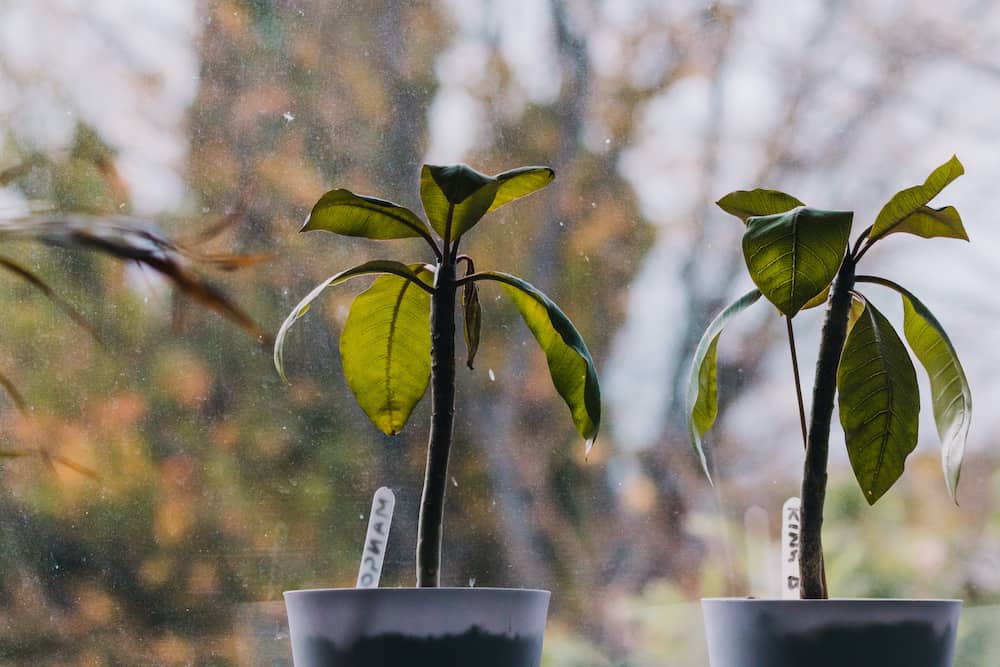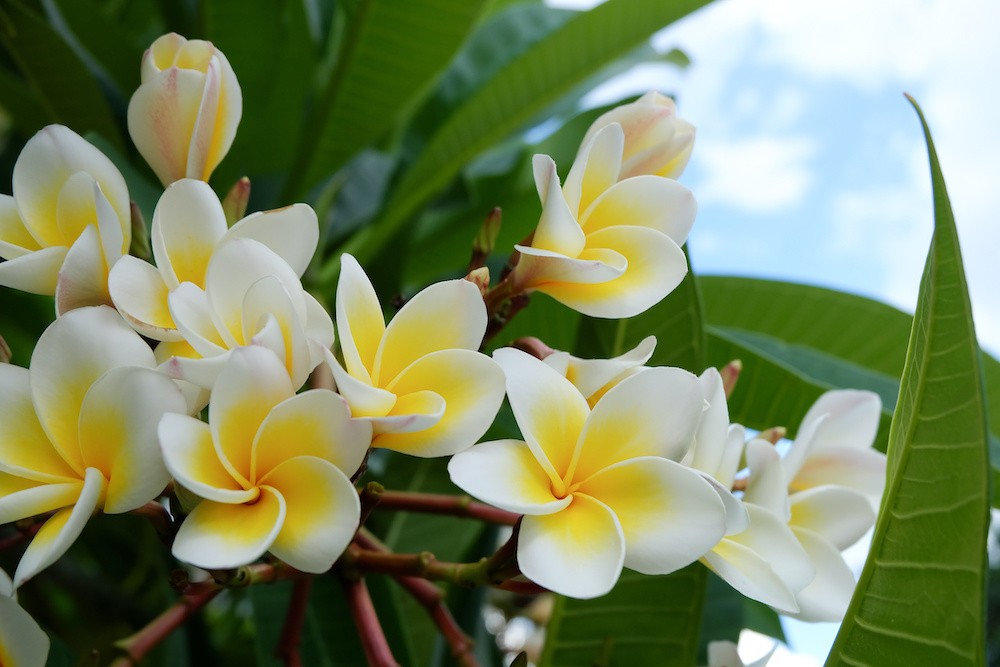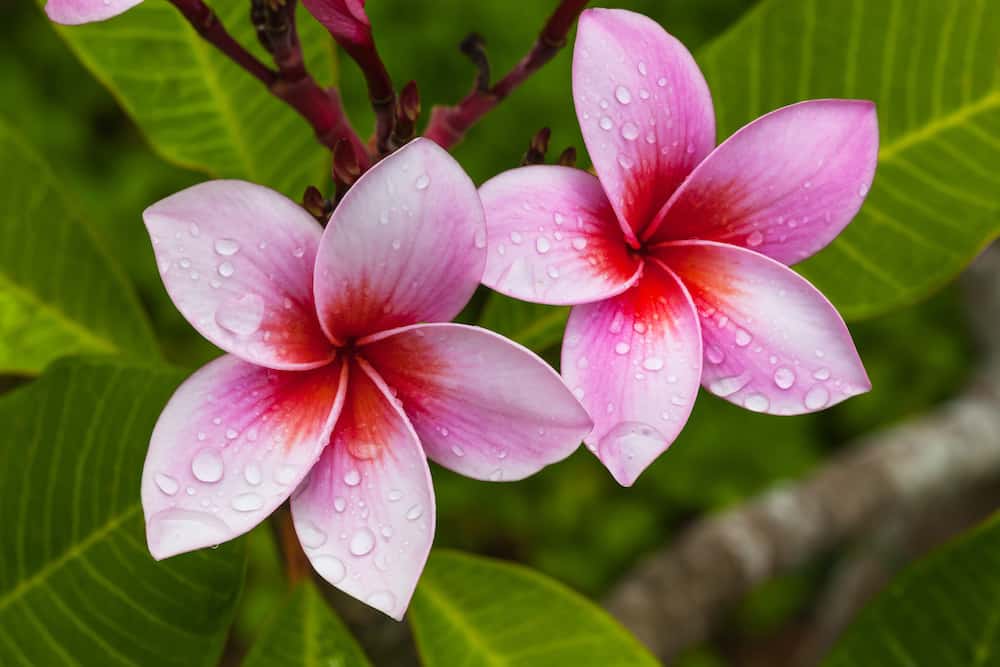Commonly called Frangipani, plumeria is best known as the flowers in Hawaiian leis. Plumeria flowers are fragrant and waxy. They have long and leathery green leaves. You can grow them as small trees, shrubs, or houseplants.
Growing in a container is ideal and makes it easy to move indoors in cold weather. For optimum flowering, they should have a full sun, all day. However, with a half-day of direct sun, they will still produce vibrant blooms.
We explain what it takes to grow plumerias and provide a step-by-step guide on how to care for them.
Plumeria
Native to Central America, Venezuela, and Mexico, it’s a member of the Apocynanceae (dogbane) family and is related to periwinkle and oleander.
Plumeria grows best in USDA hardiness zones 9 – 12 though you can grow it in other zones with enough sun and proper care. Frost is the biggest concern when growing.
Whether you grow it as a bush, ornamental tree or a plant, they result in highly fragrant flowers. The USDA’s Forest Service considers all parts to be toxic. Of the many species and varieties, most are deciduous though some are evergreen.
How to Grow Plumeria
When it comes to learning how to grow frangipani plants, there are important requirements that you need to meet and keep in mind, such as:
-
Climate and Temperature
If you live in a colder region, you’ll want to grow frangipani in a container. If you plant them directly in the ground, you can dig them up and pot them in the fall. When winter comes, you can continue growing them indoors.
If you live in an area with moderate winters, in growing zone 9 or higher, you can keep it outdoors in the winter. Pay close attention to frost warnings. When necessary cover them with frost cloth, or bring them inside for the night.
-
Soil
Well-drained soil is essential. They can thrive in soil with slightly acidic pH. Use a fertilizer high in phosphorus. Do not use fertilizers that are high in nitrogen as this can result in few blooms. Fertilize them every other week during the summer until the end of summer so new growth has time to harden off before the winter.
When planting them in a container, you need a coarse-textured potting mix that has the ability to drain water very well.
Consider using either perlite, cactus mix, or even good old fashioned sandy soil as one of your choices. The mix will be enough to keep them well-hydrated and fed as you care for them in the winter and a controlled environment.
-
Sunlight
The Hawaiian leis also requires enough sunlight. They should have at least six hours of sunshine to thrive. The more direct sun, the better.
Planting plumeria in containers enables you to move them in areas with full sun. Also, remember that the amount of sun varies by season. As such, plan to move it as needed.
How to Propagate Plumeria
While they can be propagated by seeds or cuttings in spring, it’s much easier to start with cuttings.
Before planting plumeria cuttings, which we explain below, you’ll need to propagate them. Planting them is fairly easy, but it’s important to follow the process.
You’ll want to propagate cuttings a week before you put them in the soil. They also need to be hardened. Below are the two simple steps on how to propagate plumeria.
Get the Cuttings
To acquire them, you can either take them from an existing plant or cut a deep notch in an area where you plan to make your initial cuts. They should measure between 12 and 18 inches long.
Allow Them to Harden
Once cut, you’ll want to give them a week to harden. The reason is you want to lessen the incidents of infection and promote root growth. Alternatively, you can store the frangipani cuttings in a place with plenty of shade and air circulation.
Keep them there for an entire week and remove them when the time comes to plant. During this time, you’ll want to watch for the cut ends to ensure they are hardening.
If there are soft ends, you’ll want to make the necessary cuts until you see white wood. After you’ve made the cuts, reset the time clock for a week. Keep monitoring them as you normally do.
The sooner the plumeria plant cuttings harden, the better. While a week is a typical wait time, it could take close to a month or more for them to harden, depending on the cultivar.

How to Plant Plumeria Cuttings
Once you’ve propagated them and have them go through the hardening process, it’s time for planting. Here’s what you’ll need for this process and what you should expect beyond that:
Prepare Soil
Mix two-thirds of perlite and one-third potting soil. Make sure you have a container large enough to hold it. Alternatively, if you live in a warmer climate, consider the idea of planting it directly into the dirt or garden bed.
Dip and Sink the Cutting
To make roots grow faster, use a rooting hormone. Dip the cut end and sink it into the potting mix. You’ll want them to sink halfway down. If you need additional support, you can use stakes.
Water
Once planted, water. They should do just fine for a few weeks after. Overwatering them will hinder their growth and can cause root rot.
Wherever you plant it, in a container or in the ground, be sure they are in an area where you know they’ll get plenty of sunlight. Expect them to form roots within 60 to 90 days.
Plumeria Plant Care Guide
Even if you know how to plant plumeria cuttings, they will not thrive without proper care. The good thing is caring for these flowers is minimal. Here’s the simplest way to care for them:
Water Regularly
As mentioned, watering the Hawaiian leis immediately after planting is a must. After the initial watering, you want to make sure you water it every two to three weeks. It’s best to let them dry out between deep waterings.
Keep in mind, it will dry faster if planted in containers. If that’s the case, adhere to the “every two weeks” rule. Water deeply, and then let it dry. Otherwise, if you planted it in the ground, three weeks should be good enough.
Taper off watering into fall. Stop watering completely in winter when dormant. They can go months without water.
Apply Fertilizer
If you want to promote your Hawaiian leis plants’ best possible growth, you’ll need a fertilizer high in phosphorus. You should begin to fertilize them at the first sign of growth.
-
Fertilizer Type
There are plenty of time-release fertilizers that you can use to release nutrients over the course of a six- to nine-month period. If you use a time-release one, you can apply it once or twice a year, depending on the timing.
You’ll want to keep away from those with high nitrogen content. It will make them weaker when fully grown. They won’t bloom as well.
Be sure to stop adding potash to the soil when plumeria buds appear. A good fertilizer combination to keep in mind is 10-30-10. These numbers will contain a high amount of phosphorus, but lesser amounts of nitrogen.
-
Application Frequency
Apply fertilizer every two to three weeks beginning in the spring and continue up until September at the latest. You must stop fertilizing at least 45 days before the dormant period.
Re-Plant and/or Store Them During Colder or Winter Months
Hawaiian leis plants will not survive in winter conditions. On nights when frost is imminent, it will threaten their chances of survival greatly. Have a plan for the winter before you plant plumeria bushes.
If you live in a frost-prone climate, even in planting zones 9 and 10 can experience freezing temperatures, you’ll need a plan to protect the plumeria trees. You have a few options.
-
If planted in the ground
Cover the frangipani bushes to protect them from the frost, or dig them up and pot them to remove indoors. In some parts of the country, the weather could get cooler by the end of August or early September.
Since they are dormant in the winter, you don’t have to water them nor provide them with sunlight. As for where you should store plumeria plants, you have plenty of options.
You can use your greenhouse, garage, or a section of your basement since these places could provide the plants with sufficient conditions. So long as the storage temperatures are 50 degrees or above, they should be fine.
-
If planted plumeria in a container outdoors
They make ideal patio plants and landscape bushes with their lattice of branches. Overwinter potted plumeria indoors. Be sure to move them indoors when temperatures will be below 40 degrees F.
-
If planted in a pot indoors
Keep it in it’s container indoors year round and treat it as a houseplant. You can grow them indoors all year.
Pruning
Prune in late winter or early spring.
Insecticide
The best time to check for insects is before re-planting the plant into the ground around springtime. Regarding insects to watch out for, they can attract scale and nematodes.
Spray in the spring. Continue to inspect them regularly. Refrain from spraying insecticide if they are in direct sunlight or showing signs of dehydration.
Use year-round spray oil since it will work around the clock to kill insects and eggs. Avoid using products with synthetic chemicals since they may harm your plants. Apply as needed or periodically as a precautionary measure to eliminate the eggs.
Strengthen the Roots
At the first sign when your Hawaiian leis plants are “waking up” from dormancy, it would be a good time to give them a boost (weather permitting).
You’ll want to soak the plumeria roots in a container of water mixed with a root activator and bio stimulate. It will strengthen the roots, so they are well-fed while in the ground.

Facts
It is classified as follows:
Family: Apocynaceae
Genus: Plumeria L
Species: Plumeria obtusa L
Other names for plumeria include frangipani, nosegay, Hawaiian leis flowers, and Singapore graveyard flower. The waxy flowers have five petals and are highly fragrant. The sap is milky and poisonous.
It can grow as a bush, tree, or indoors as a houseplant. Trees can grow 25 feet in height.
FAQs
How many colors of plumeria are there?
There are many colors: shades of purple, red, pink, orange, yellow, cream. There is also a variety with white flowers. Hybrids are often two colors.
What are the different types of frangipani?
In addition to hybrid varieties, the different types are Plumeria:
- Obtusa
- Pudica
- Rubra
- Stenophylla
What is the common name for Plumeria rubra?
Common names for Plumeria rubra are nosegay and frangipani.
Is plumeria and frangipani the same thing?
Yes, they are the same thing.
Is there a blue plumeria?
How long does it take plumeria to bloom?
How big do plumeria trees get?
These trees will grow at various heights. The range will be anywhere between 25 and 40 feet with thick branches and a plump trunk. In tropical climates, you can expect these trees to be even wider than those grown in other areas of the country.
When planting them in the ground — without the threat of frost — they will typically grow taller than growing them in a container. You could grow a plumeria tree on your patio and expect it to grow anywhere between five and 15 feet.
Are plumerias poisonous?
This is where things do get a bit confusing. While plumeria flowers are edible, all parts of the plant are mildly toxic. The tree sap from a plumeria tree can cause skin irritation and rashes.
When ingested by animals, it can cause irritation and other mild digestive problems such as nausea and diarrhea. Regardless, if your cat or dog has ingested plumeria, make an appointment to see their veterinarian as soon as possible. Other than that, they are not dangerous compared to some other plants.
Use a pair of gloves and long-sleeved clothing when tending to them in the garden.
What is a plumeria Noid?
Gorgeous Flowers for Your Garden
If you have a bit of a green thumb, why not try your hand at growing these colorful, fragrant flowers.
Growing and caring for them is actually pretty easy. That said, you’ll want to follow the instructions above to ensure they grow properly and are healthy throughout their lifespan.
While they thrive better in tropical environments, they are great for growth and care in the summer months, no matter where you are in the country.
In the winter months, when they are dormant, they need little care other than being placed in a climate-controlled environment that allows them to “sleep” properly.
Once you start planting these beautiful tropical flowers, your garden will become the envy of the neighborhood. This simple five-petaled flower is a way to make your garden look beautiful.
As long as you follow the proper care guide, the plant will serve you well in the long run. If you want to grow your own to make your garden stand out, you’ll want to know more about it and the perfect environment for it to thrive in.
Plumeria is recognizable for their use in creating Hawaiian leis. Since it is a tropical plant, it requires an environment different from what’s required of other flowers that grow in cooler climates.

